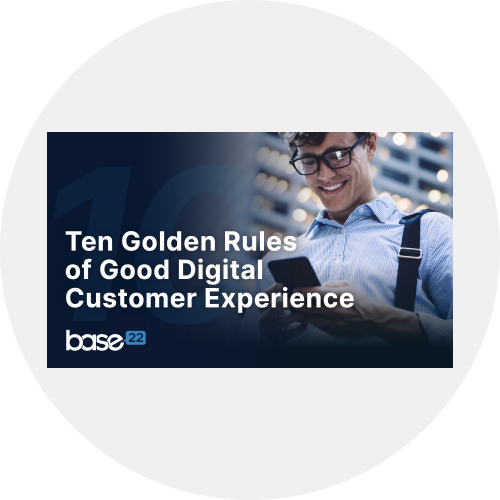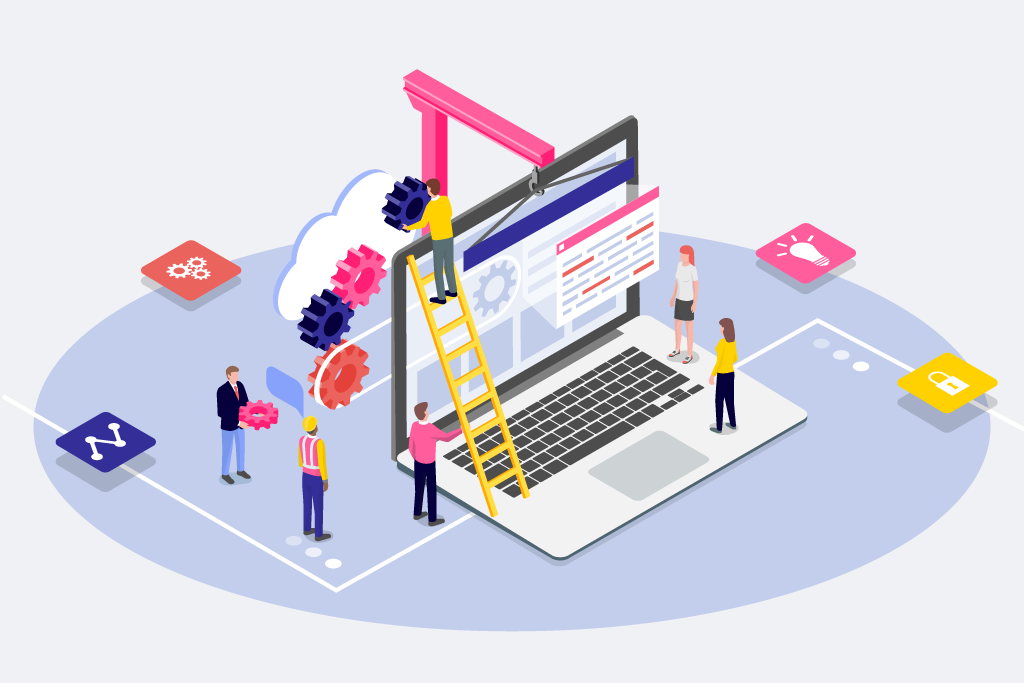When we jump into the trenches with a client, the term “digital experience design” often pops up. Digital experience (or DX) is a popular term that’s closely related to the concept of customer experience (CX). It feeds off of fields like innovation, marketing, user experience (UX) design, and service design, and also from expectations and pain points of users in the digital world. Today, digital experience design is not only a best practice but an essential process for building engaging, relevant digital channels.
If a growing company or organization needs to connect and engage with a key audience (like employees, customers, or B2B buyers), digital experience design comes into play. It means to plan and envision what a company wants to convey through a digital channel: brand values, key messaging, emotions, or a specific result. Digital experience design is closely tied to business growth: without it, there’s no strategy on how digital channels will attain traffic, drive purchases, or build loyalty.
In this article, you will find key questions and points of discussion for your road to improving your digital experience design efforts. These insights might help you to reduce the risks of deploying “empty shells” that yield little to no results. At the end of everything, don’t you want to reach your customers the right way every time? Focusing on a cohesive experience has far-reaching impacts.
Let’s sync up first: What is Digital Experience Design?
Digital experience encompasses all digital interactions (or touchpoints) between customers, suppliers, employees, and the organization itself—the entire business ecosystem.
We also share Nielsen Norman Group’s approach, which takes this concept one step further: experience is the delivery of the brand promise, and that’s why it is important to have a consistent “experience across interactions with a company or product”. If the digital experience is tied to the brand promise, then it’s closely integrated with Marketing.
Let’s hold on to that thought for a second. Most companies that are in the midst of a Digital Transformation require years to fulfill the digitization process and start with strategic initiatives, like a B2B portal for their distributors, or a brand-new app targeting click-and-collect service.
However, when a company reacts to market pressure and rushes an initiative without ensuring it corresponds to a greater vision or their business ecosystem, there’s a risk this new project will offer a fragmented experience or isolated experience.
What’s the worst thing a company can do in a marketing, branding, or selling scenario? Provide a fragmented digital experience. When a website, portal, or app don’t reflect the same values or emotions, user engagement will most likely be affected.
How can you make sure that all your digital initiatives are aligned so they meet and attend to users’ needs as well as to specific business goals? Continue reading for our insights.
Digital Experience Design: 4 Key Questions for Your Business
Question 1: Are your digital initiatives part of the bigger picture?
Often, companies advocate for bold new projects as if they are a unique shot to fix pain points for their current products or services.
Think about a freshly redesigned app for an amusement park that has a weak presence in the digital world. Here are some basic questions to start with:
- Are mobile devices the main channel to communicate with your type of customers?
- How does the app relate to the park’s website and availability of online tickets?
- Does the website offer the same or better experience than the one in the new app?
- How does the customer service staff in the park interact with the app?
- What functionalities does it add or compliment to those that your audience already knows and owns?
Remember that an amusement park app can provide customer service if customers suffer from long waiting lines for a ride, but it can hardly fix the pain point itself. Your brand can suffer if the expectations for the app do not meet its offering.
A better solution would be to design a solution or touchpoint for your digital assets that might help you to fix the long waiting likes—like a priority pass or convenient push notifications to avoid waiting in line. But this will require much more than an app: it will touch operations and the business model.
Furthermore, investment in technologies intended to bolster brand awareness and market presence might be better suited to solving the problem. These solutions also benefit the overall digital experience.
The aggregated value of digital experience design and the vision of a seamless digital environment is what is going to create an engaging overall experience for your customer. After all, connectivity and communication are two of the forces behind digital transformation.

10 Golden Rules of Good Digital CX
Check out our booklet on Customer Experience for large and growing organizations.
DownloadQuestion 2: What problem are you solving with your initiatives?
Creating experiences for the digital world takes the “product market fit” concept and turns up the heat. It requires a deep understanding of your users’ needs (not only their demographics or consumption patterns) and being able to make a difference in their lives. With cognitive technology, machine learning, and data collection, knowing what our audiences do and want might be more achievable for than ever before. How well we understand the issue and how we design for it are completely different matters.
Consider the previous example of the amusement park and the new app. Let’s focus on the issues it resolves:
- Which pain point is the app attending to?
- Does the app help sell more tickets, enhance the customer experience in the park, or communicate the updates and news from the park more efficiently?
- Is there a research effort by the amusement park to understand which of the many users’ needs is the priority and most important for their operation?
This cannot be stressed enough: those who offer digital experiences that do not correspond to relevant user needs are doomed to fail. In the digital world, empty shells are instantly met with no engagement, no traffic, and no conversions.
The same happens with developing experiences that respond solely to untested business processes or idealized business results. If a new product or service is not targeted to a specific need or task, how do we expect the digital experience design to be relevant, to make sense to the customers, or to become an important channel of value in their daily lives? This comes down to how we communicate with the end user, how we serve them, and ultimately, how we build the experience for their needs.

Question 3: Who really owns the digital experience design?
Is it customers, employees, or influential stakeholders? Is it Sales, Marketing, C-Level executives? Who really owns the digital experience design is a big question, and one that comes up frequently when we talk to businesses and clients. Many companies are committed to offering their clients and customers cutting-edge technology and responsive and intuitive design, but what happens to those who oversee and maintain the brand?
Are you providing the same technology and the same considerations to your employees or those who work with you, like suppliers, providers, franchises, distributors, and dealers?
While one audience is treated well (like your customers), another audience can be underserved, creating fragmented digital experiences. In our example of the amusement park, the company can create a rich and powerful app that can be used to interact with every ride available, but at the same time it can have an employee portal where all the documentation for the operation of the rides is scrambled or confusing. The disconnection between these two experiences negatively impacts the delivery of the brand promise.
71% of employees want the company they work for to provide the same level of technology that they use in their personal lives, according a Salesforce report. If we want our employees to embody our brand, the brand should also deliver its promise to them.
Question 4: How good are you (or your business) at leveraging existing resources?
When we talk about a digital environment, it doesn’t necessarily mean that a company needs to develop a native application for each audience from scratch, as we have discussed before in this blog. Rather than ticking a checklist of different devices, sometimes developing a responsive design for a catalog or a website can extend the experience for your user in a relevant manner. The key factor here is bringing in something different and integrating it to make the experience richer and more robust. In this instance, brand identity is nothing more than consistency, but consistency might be just what the end user is asking for.
Again, it is important that you, as a company, have a very clear understanding of your audiences, their needs, and their behaviors, as well as your current resources and infrastructure. Considering the potential of your business model, you can design an experience that employs your information and resources and positively improves the experience of connecting meaningfully with users in the name of the brand.
Final thoughts: The Key to Effective Digital Experience Design
Like it happens with buzzwords, a rich digital experience design for your brand requires a lot of strategy and strong implementation capabilities. In a way, the craftmanship behind every modern interface and every digital service has gotten us to the point where we can’t afford to be casual or superficial anymore, whether you are B2C or B2B.
Audiences are pickier than ever, and making stuff that looks good rather than adds value is not enough. This is good for business — it highlights our potential, forces us to be better at what we do, and drives us to have a bigger and bolder vision. But it is bad for a company whose assumptions aren’t well-aligned or whose efforts are stagnant rather than constant.
What are your thoughts on digital experience design? Are there any other questions you think are crucial for your Digital Transformation? What have you done in your company to guarantee consistent growth and an integral brand strategy? At Base22, we specialize in guiding companies down the path of improving and transforming their digital business. Send us a message, and let’s start working on your digital future.
Article written by Ben Bishop and Isabel Villarreal, Digital Marketing.

Designing Modern Digital Experiences
Build, improve, or redesign your portals and mobile apps with our Digital Design services. Target satisfaction and growth.
Learn more


